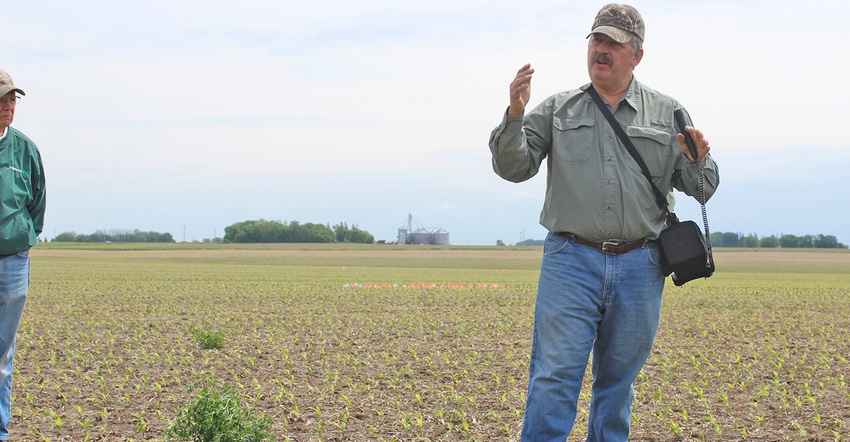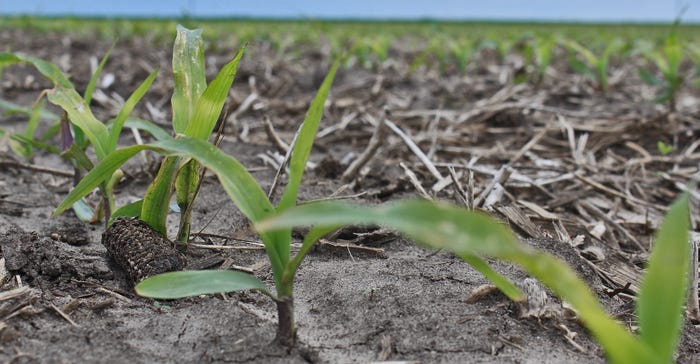
Cindy Hamilton remembers the first call she received from someone who wanted them to do aerial seeding of cover crops.
It was from someone deep in southeast Minnesota — the "hill country," as her husband, Terry, calls it. He thought Cindy took down the information wrong. Who would want to be planting in the fall?
But the next year, they received a couple other calls, and their journey with cover crops began. Last year, they aerial-seeded almost 20,000 acres of cover crops from the last week of August to the first of October.
"I'm farming with an airplane," Terry says.

Terry Hamilton planted this corn in mid-April using the strip tillage system one day after a burndown herbicide application to his winter wheat cover crop. This fall, he will aerial-seed cereal rye into the corn as a cover crop. It was planted at a depth of 2¼ inches, and the plant population is 37,000. He hopes to hit 250 to 260 bushels per acre this year.

Change at their own farm
Terry and Cindy Hamilton farm and operate Midwest Ag Air in Adams. Their son, Travis, works with them, and was one of the driving forces behind their shift away from conventional tillage and no cover crops. They began to plant cover crops on all their 800 acres, plant their corn into strips and no-till their soybeans into cornstalks.
"I probably wouldn't have done this, if not for him [Travis]," Terry says.
They first planted cover crops on their land in 2014, seeding 400 acres.
"Go big or go home," Terry says.
The next year, they realized there was a need for research — and fast. People were turning away from cover crops after a bad experience, and they didn't have answers as to why a crop failed. They conducted research on their land and on the land of neighbors, taking a 5-gallon bucket into the field and spreading seed in 20-foot squares on land where they knew what herbicides had been applied to determine herbicide interaction with the crops.
Get more INSIGHT: Download Cover Crops: Best Management Practices now!
Their research has been hands-on, developed through trial and error. They have developed a checklist they go through with new customers before seeding cover crops. They have found resources at Michigan State University, Penn State University and the University of Missouri for herbicide carryover issues, and the University of Wisconsin for resources regarding the use of cover crops as forage. Terry encourages farmers who are thinking about cover crops to set up their chemical program with cover crops in mind. Otherwise, the cover crop choices are very limited. Some chemicals have a 40-month residual.
In 2016 and 2017, they seeded their entire 800 acres with cover crops. It's been — and continues to be — a learning experience.
Perhaps the biggest hurdle was psychological, Terry says. Farming with cover crops and little tillage is doing things differently from what your father or grandfather did. It's hard. The first time he planted beans into cornstalks, Terry thought his dad would rise from his grave and hit him. It's changing 200 years of tillage.
However, he felt that something needs to change. Soil moves. It's showing up in ditches, and the public and government officials are taking notice.
"If we don't try and solve this, they're going to solve it for you," he says.
Cover crop practices, yield impact
The Hamiltons plant cereal rye into corn and winter wheat into soybeans. There are always thin spots, but it doesn't seem to matter what's happening aboveground — it's about feeding the fungi belowground.
The cover crop is terminated at least one day before planting.
Terry and Cindy have noticed some changes in their soils.
The soil structure resembles cottage cheese, rather than what Travis describes as "moon rocks."
It's made the soil more sponge-like, Cindy says, and able to absorb more water.
What about yield?
"I haven't lost yield," Terry says.
Terry continues to learn about cover crops and relies on others for their expertise. Both Terry and Cindy want to help others learn about using them, too. They hosted a cover crop tour for Mower County Soil and Water Conservation District in May that drew 100 people. They hope farmers on the tour had their interest sparked and will interact with others to learn more about cover crops.
Kubat Willette is digital content creator and a writer with Farm Progress Cos.
About the Author(s)
You May Also Like




